Glittery, feature-laden flagship products may be sexy, but in today’s world the bread-and-butter models are the ones that return the most bang for the least buck. So it’s no surprise that the roughly $5,000 YZF-R3 was the top-selling Yamaha motorcycle overall in 2018, a spot it swaps regularly with another inexpensive grin factory, the FZ/MT-07.
Read our Road Test Review of the 2018 MT-07 here.
The R3 debuted in 2015, a bit late to the lightweight sportbike party, but it immediately impressed us with its fun factor and everyday usability. For 2019, the R3 got a makeover that includes a new upside-down 37mm KYB fork, new triple clamps, an updated KYB rear shock, new radial Dunlop Sportmax tires, a redesigned fuel tank, lower clip-ons and a facelift that ties it to its YZR-M1 (much bigger) brother. While we like the new look, it’s the suspension updates that take the littlest YZF to the next level.
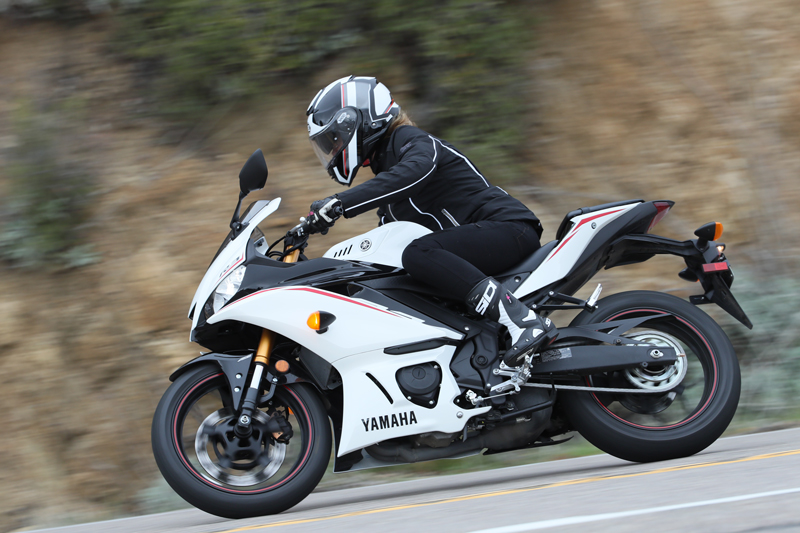
Jenny’s Gear
Helmet: Shoei Neotec II
Jacket: iXS Delayla
Pants: iXS Classic AR Stretch
Boots: Sidi Performer Lei
Up front, the spring rate was increased by 20 percent and rebound and compression damping were also dialed up, addressing our complaint that the previous fork was “spongy, with weak rebound damping letting the front-end recoil too fast from impacts.” A new cast aluminum top triple clamp and forged steel lower triple clamp combine with the stout USD fork to create a much more planted feel that provides better feedback than before.
It’s also a better match for the 7-step preload-adjustable rear shock, which got an 11-percent stiffer spring, 10mm higher preload, increased rebound damping and slightly decreased compression damping. Overall it works very well in combination with the steel trellis frame; as I tossed the 379-pound machine through the banked corners of Palomar Mountain in San Diego North County, feedback from the front end let me focus on having fun rather than worry about running out of talent (or traction).
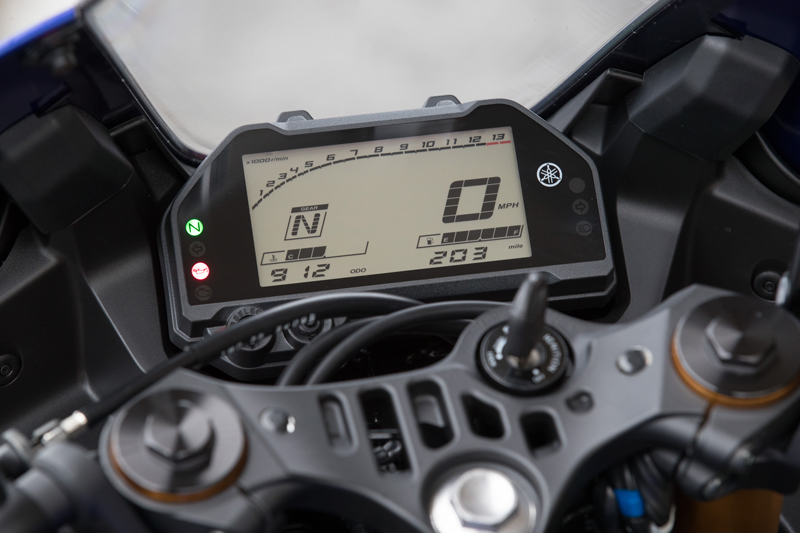
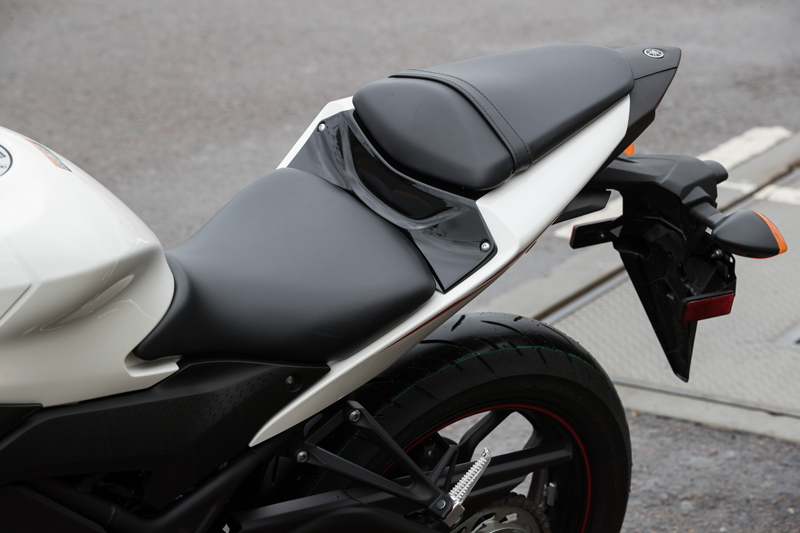
Speaking of traction, the first-gen R3 wore bias-ply tires rather than radials. An easy enough aftermarket swap, but for 2019 Yamaha has sensibly shod the R3 with proper radial Dunlop Sportmax GPR-300 rubber. We’ve had good experiences with Sportmax tires in the past, and this is no exception; the R3 stayed glued to the pavement even on damp mountain roads and when keeled all the way over on a favorite set of technical twisties.
If there is a sport riding shortcoming, it’s the brakes; the two-piston caliper at the front and single-piston at the rear just aren’t up to the demands of what is otherwise a very capable machine. ABS is available, but only on the Vivid White or Matte Black versions, not the eye-catching Yamaha Team Blue.
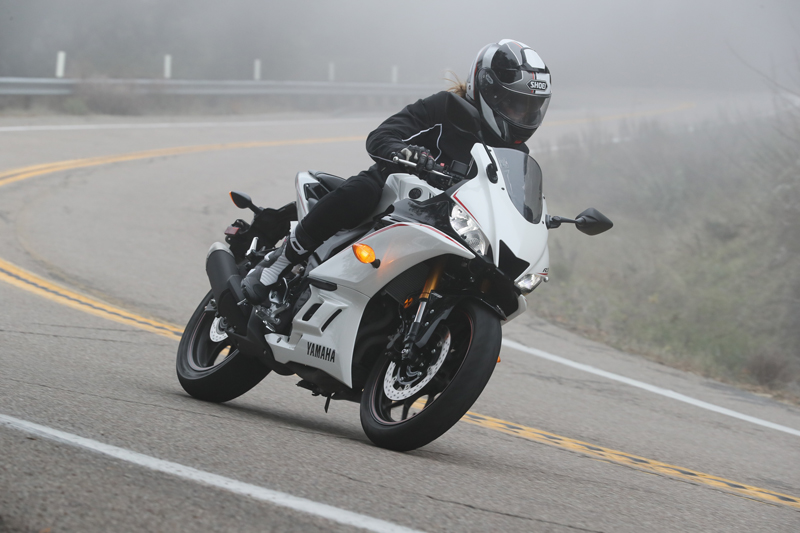
Under the “if it ain’t broke, don’t fix it” category is the 321cc liquid-cooled, DOHC, 4 valve-per-cylinder parallel twin, which spun out 35 horsepower at 10,600 rpm and 19 lb-ft of torque at 9,200 when we last put it on the Jett Tuning dyno in 2017. Gears first through fourth are rather low, maximizing grunt, but there’s an interesting bump in both power and torque right after 6,000 rpm. The result is impressive roll-on performance even at a high gear-to-speed ratio. Highly entertaining, but also practical for freeway commuters.
And I suppose that’s the point of the R3: it’s affordable, but now it’s an even more capable sportbike that should lengthen its buyers’ “out-growing” timeframe. The trick is walking (riding?) that fine line between sporty and comfy, and even with its 20mm-lower clip-ons, I found the R3’s ergonomics to be a pleasant balance between the two.
Check out our review of the 2018 Kawasaki Ninja 400 ABS here!
The day after our 140-mile press launch ride, I logged more than 150 freeway miles from Oceanside, California, to my home in Camarillo, with no ill effects: no pain and no numb hands, bum or feet. Plus, despite keeping up with 75 mph California traffic, I only went through 2.4 of the 3.7 gallons in the tank, for a respectable 65 mpg.
There’s a lot to like about the 2019 Yamaha YZF-R3: good looks, sporty yet comfortable ergos on a well-balanced chassis, vastly improved suspension and a price that’s unchanged from last year. Bring on the track, twisty roads, daily commute or even a weekend trip; this bread-and-butter staple of Yamaha’s line is getting better with age.
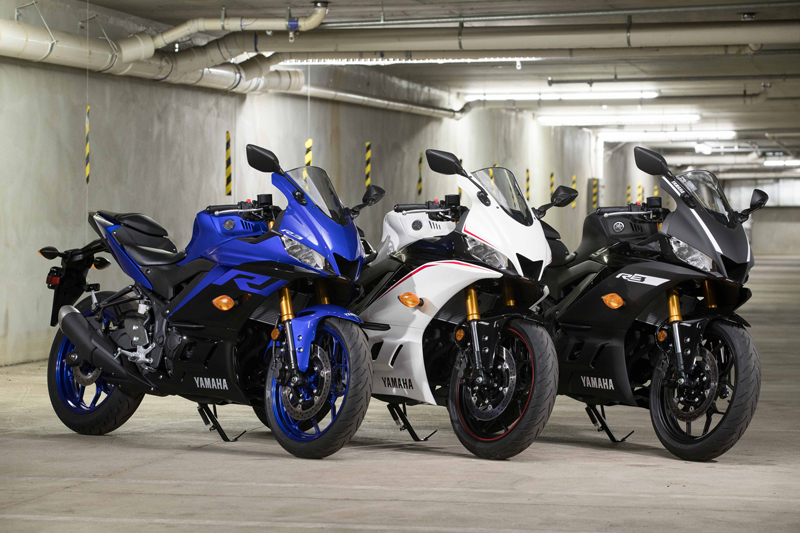
2019 Yamaha YZF-R3 Specs
Base Price: $4,999
Price as Tested: $5,299 (ABS model)
Warranty: 1 yr., unltd. miles
Website: yamahamotorsports.com
Engine
Type: Liquid-cooled, transverse parallel twin
Displacement: 321cc
Bore x Stroke: 68mm x 44.1mm
Compression Ratio: 11.2:1
Valve Train: DOHC, 4 valves per cyl.
Valve Insp. Interval: 26,600 miles
Fuel Delivery: EFI
Lubrication System: Wet sump, 2.7-qt. cap.
Transmission: 6-speed, cable-actuated wet clutch
Final drive: O-ring chain
Electrical
Ignition: Electronic
Charging output: 298 watts @ 5,000 rpm
Battery: 12V 7AH
Chassis
Frame: Steel diamond-type, engine as stressed member
Wheelbase: 54.3 in.
Rake/Trail: 25 degrees/3.74 in.
Seat Height: 30.7 in.
Suspension, Front: 37mm USD KYB fork, no adj., 5.1-in. travel
Rear: Single linked rear shock, adj. for spring preload, 4.9-in. travel
Brakes, Front: Single 298mm disc w/ 2-piston caliper & ABS (as tested)
Rear: Single 220mm disc w/ 1-piston caliper & ABS (as tested)
Wheels, Front: Cast aluminum, 2.75 x 17 in.
Rear: Cast aluminum, 4.00 x 17 in.
Tires, Front: 110/70R-17H
Rear: 140/70R-17H
Wet Weight: 379 lbs.
Load Capacity: 349 lbs.
GVWR: 728 lbs.
Performance
Fuel Capacity: 3.7 gals., last 0.8 gal. warning light on
MPG: 87 PON min. (low/avg/high) 52.1/59.1/64.7
Estimated Range: 219 miles
Indicated RPM at 60 MPH: 6,500


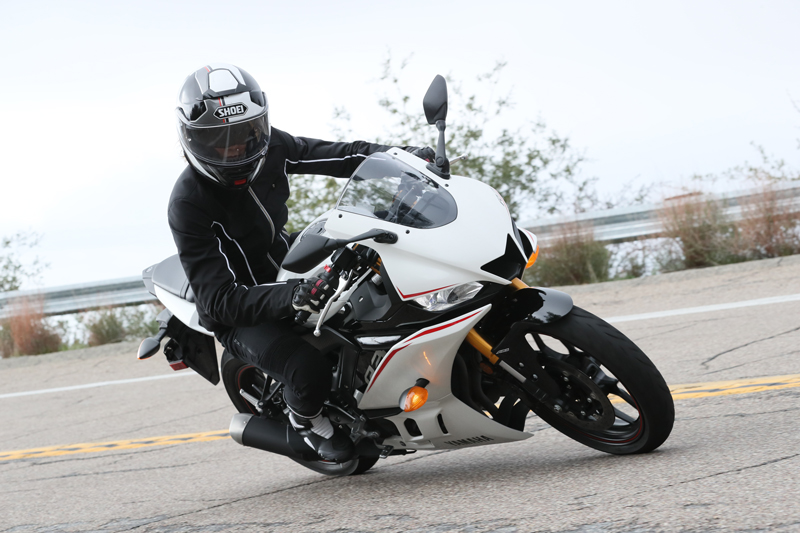











Enjoy these motorcycle reviews very much!